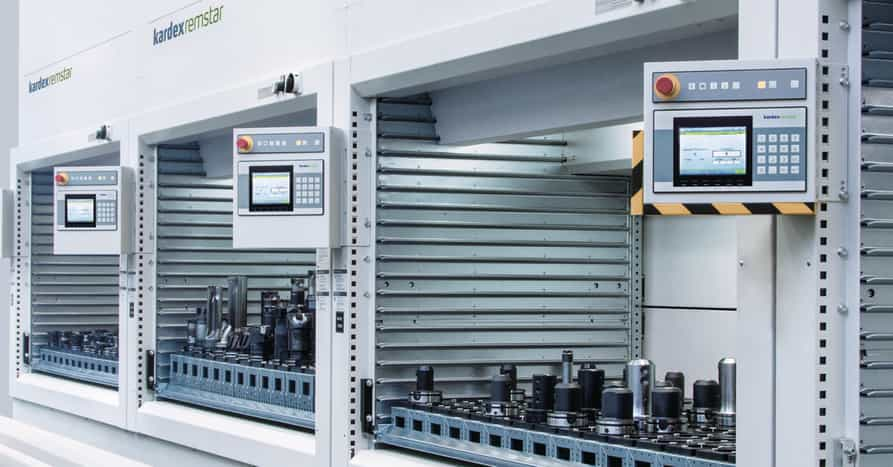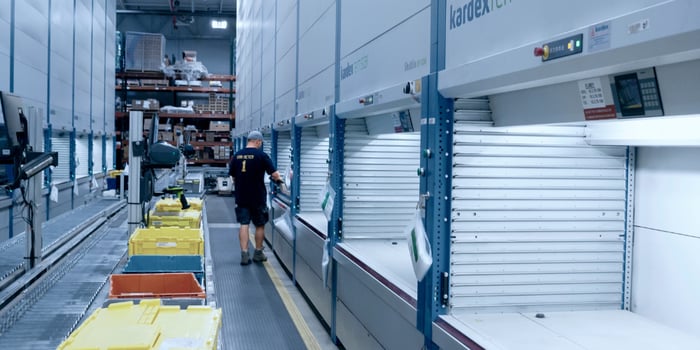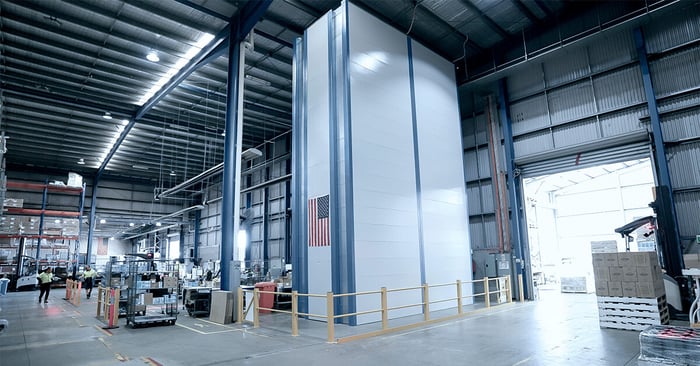As demand grows for a wider variety of parts in smaller batches, manufacturers are running shorter production jobs more frequently.
Each new job often means a tool change, and those changeovers can eat up valuable production time if tools, dies, and molds aren’t readily available and easy to handle.
That’s why having a well-organized, efficient system for storing and retrieving these critical components isn’t just nice to have — it’s essential. Whether you're managing custom metal dies, precision molds, or specialty tooling, you need a solution that helps you locate, move, and change tools quickly and safely.
Automated storage systems offer a modern solution to these challenges.
By optimizing storage through vertical automation, you can reclaim valuable floor space, enhance safety, minimize downtime, and ultimately maintain your production line at peak efficiency.
In this article, we explore how fast-paced precision manufacturers can benefit from streamlined, automated vertical storage solutions for metal dies, molds, tools, and spare parts.
We’ll also take a look at how Intech revolutionized their inventory with automated storage systems and was able to recover 10,000 square feet of floor space vs traditional shelving.
Ready?
Let’s dive in.
Why Efficient Die and Mold Storage Matters in Manufacturing
In many manufacturing facilities, tools, metal dies, and molds are still stored the old-fashioned way — placed on pallets, lined up along walls, or stacked on the floor wherever there’s room. These components are heavy, bulky, and often stored far from the production line, making retrieval a time-consuming task.
Traditional Tool Storage Wastes Space and Time
Even if your team knows where a specific mold or die is supposed to be, simply reaching it can require long walks across the facility, forklift maneuvers, or awkward lifting.
Over time, this results in lost productivity and unnecessary physical strain on your workforce.
Additionally, floor storage consumes valuable square footage that could be utilized for revenue-generating activities.
Disorganized metal die or mold storage doesn’t just slow things down — it introduces risk. Tools can be damaged through excessive handling, and workers are more likely to be injured when retrieving or moving heavy parts without ergonomic support.
That’s where automated tool storage systems come into play.
-1.jpg?width=1000&height=667&name=Kardex_img_customer_USNR_12%20(1)-1.jpg)
Automated Vertical Tool Storage
Vertical automation solutions, such as Vertical Lift Modules (VLMs) or Vertical Carousel Modules (VCMs), are designed to store heavy tools, dies, and molds in a compact, vertical footprint. Instead of sprawling storage areas across your facility, automation allows you to use your vertical space efficiently, reclaiming up to 85% of your floor area.
These systems don’t just save space — they streamline access.
But how do they work?
With the push of a button, the exact tray or shelf containing the needed item is brought directly to the operator at an ergonomic height.

No forklifts, no long walks, and no digging through shelves. Whether you’re dealing with a 50-pound die or a delicate mold, vertical automation makes storage and retrieval faster, safer, and smarter.
Learn about the 8 types of ASRS here.
By optimizing your metal die storage and mold storage with automation, you can create a more organized, productive, and safer environment — all while gaining the flexibility needed for high-mix, low-volume manufacturing.
ZOLLER Inc. specializes in tool management software, providing efficient and process-reliable cutting tool handling within the manufacturing process. They use Kardex Shuttles in their Tech Center to store their tooling instruments.
“The Kardex Shuttles are the most efficient way to keep tooling secure, clean and organized, and in a very small and compact footprint.” said Alexander Zoller, President of ZOLLER. Read more about Zoller here.
The Benefits of Automated Storage for Tools, Dies, Molds, and Spare Parts
1. Instant Access to Tools & Instruments
Automated tool storage systems eliminate the time and guesswork involved in manually searching for the right equipment. With digital inventory tracking and push-button retrieval, your team can instantly access any stored metal die or mold without having to walk the floor or use a forklift.
Automated vertical storage not only reduces downtime but keeps your operations running on schedule, especially during frequent changeovers.
2. Optimized Storage Footprint
Traditional shelves eat up valuable floor space.
By storing vertically instead of horizontally, solutions like Vertical Lift Modules (VLMs) and Vertical Carousel Modules (VCMs) maximize your cubic space.
Whether you're working with large molds or heavy metal dies, automated vertical storage solutions enable you to store more in a smaller footprint.
In a recent Kardex customer survey, 78% of Kardex Remstar customers listed better space utilization as a top benefit.

3. Improved Organization and Inventory Control
Automated systems assign fixed digital locations to each item, ensuring that every tool, die, mold, or spare part is always in its exact location.
Integration with inventory management software enables you to track usage, maintenance schedules, and availability in real-time.
No more misplaced tools or delays caused by searching — just a clean, well-organized storage system that keeps everything under control.
Changeovers don’t end when the new tool is in place — the previously used tool still needs to be returned to storage.
And if that process is slow, awkward, or unsafe, it creates another productivity drain.
Automated systems simplify this final step by providing easy return access at an ergonomic height. With designated storage locations and barcode scanning, each mold or die is quickly returned to its correct spot, ready for the next use.
It’s an end-to-end system that keeps your shop organized and operating at peak efficiency.
Get more ideas on how to organize your warehouse here.
4. Fewer Handling Errors and Reduced Risk of Damage
Manual handling often leads to dropped tools, misplacement, or even damage to high-value dies and molds.
Automated storage minimizes human contact by delivering items directly to the operator at an ergonomic height. This controlled retrieval process helps protect your investment and maintain part quality throughout the production lifecycle.
5. Faster Changeovers and Greater Production Flexibility
When tools and molds are easy to locate and retrieve, changeovers become faster and more predictable. Automated storage supports lean manufacturing by helping your team adapt quickly to new jobs or smaller batch sizes.
Whether you use a manual trolley, motorized cart, or fully automated guided vehicle (AGV), automation ensures that stored items are always ready for immediate handoff.
For operations juggling frequent changeovers, this tight coordination between tool storage and production makes a huge difference in daily productivity. This leads to less downtime, more uptime, and the agility to meet customer demands without missing a beat.
When every minute of production time counts, waiting on a missing die or searching for a specific mold isn’t just frustrating — it’s expensive. Automated tool storage systems eliminate this bottleneck by delivering the exact tool needed at the push of a button.
Instead of relying on tribal knowledge or hunting down a forklift, your team can access critical components immediately. Whether you’re switching dies between short runs or alternating between different mold types, the time saved adds up fast.
Once the desired tool, die, or mold is located, it then needs to be moved from the storage area to the location of the machine. There are several types of cranes and ergonomic lifting devices available that can be used to get the tool, die, or mold out of storage and onto your chosen method of transport (forklift, manual, or automated cart or trolley).
When thinking about moving the tool, die, and mold from storage to production, you want to reduce handling as much as possible, as there is an opportunity for worker injury and product damage with extensive handling. Find an ergonomic solution that protects the worker and safeguards the part from damage.

Not to mention, delayed or incorrect changeover can lead to more than just lost time — it can cause part defects, wasted material, or damaged tooling. By ensuring quick and accurate access to the right tools, automated tool storage systems help prevent costly errors that impact both quality and delivery timelines.
6. Protect Workers with Ergonomic Lifting Solutions
We know we don’t have to remind you that metal dies and molds can weigh hundreds of pounds, and moving them manually (or incorrectly) poses a serious risk to workers. When paired with automated tool storage systems, ergonomic lifts, cranes, or hoists allow operators to retrieve items at waist-height and move them safely without bending, stretching, or straining.

OSHA and workplace safety standards place increasing importance on ergonomic handling and injury prevention. Automated storage systems — by design — support compliance by reducing high-risk tasks and ensuring that heavy components are handled in a controlled, safe environment.
By minimizing manual lifting and awkward movements, you reduce fatigue, prevent back injuries, and create a safer work environment overall.
Lowering the risk of injury doesn’t just protect your team — it protects your bottom line by reducing workers’ comp claims and unplanned downtime.
Learn how automation can help to solve the labor crisis in manufacturing here.
7. Keep Up With High-Mix, Low-Volume Demands
Today’s manufacturing environment demands flexibility.
Smaller batch sizes, custom configurations, and rapid turnaround times have become the norm. Automated storage gives your team the agility to respond to changing production schedules without sacrificing efficiency.
By integrating storage systems with your production planning software, you can queue up tooling in advance, prepare for upcoming jobs, and ensure the right components are always ready — no delays, no missteps.
It all sounds great on paper. But does it really lead to ROI?
Absolutely.
In fact, most Kardex Remstar customers saw ROI on their investment in the first 12 months, with one-third of those customers achieving ROI in the first three months. 
Here’s one real-life example of automation in action:
Real-Life Example: Intech Gains Control and Space with Kardex and ZOLLER
At its 100,000-square-foot facility in Athens, Alabama, orthopedic device manufacturer Intech faced growing challenges managing thousands of tooling components across 80 CNC machines.
Manual tracking with clipboards and spreadsheets led to misplaced tools, redundant purchases, and wasted time. To bring order to the chaos, Intech implemented a fully integrated system using three Kardex Shuttle Vertical Lift Modules paired with ZOLLER TMS Tool Management Software.
The result was a streamlined process for storing, accessing, and tracking over 10,000 items — from cutting tools to large fixtures.
In just the first year, the system delivered measurable improvements, including:
- $100,000 saved by eliminating duplicate tooling purchases
- 10,000 sq. ft. of floor space recovered
- Record $50M in annual sales, supported by improved productivity
- Full digital visibility of inventory, accessible shop-wide
With scalable integration and zero reliance on tribal knowledge, Intech now has the foundation to support ongoing growth, system expansion, and long-term operational efficiency.
Upgrade Your Tool, Die, and Mold Storage With ASRS
If you're still relying on floor storage, outdated racking, or manual handling for your tools, metal dies, and molds, you're leaving time, space, and productivity on the table.
Automated tool storage systems — such as Vertical Lift Modules (VLMs), Vertical Carousel Modules (VCMs), and our robust inventory management software — are purpose-built for manufacturers seeking safer, faster, and more innovative solutions.
Whether you're working with heavy dies, delicate molds, or precision tooling, automation helps you:
- Locate parts instantly
- Reduce handling injuries
- Save valuable floor space
- Speed up changeovers
- Extend the life of high-value equipment
From small job shops to global manufacturing plants, Kardex systems are already streamlining metal die and mold storage in facilities worldwide.
Not sure which solution is the best fit for you? No problem. Contact our team today to connect with an automation expert.







